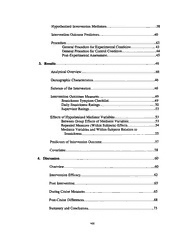
DTIC AD1012149: A Cognitive Behavioral Intervention for Seasickness PDF
Preview DTIC AD1012149: A Cognitive Behavioral Intervention for Seasickness
UNIFORMED SERVICES UNIVERSITY OF THE HEALTH SCIENCES 43)1 JONESBRIDGEROAD BETHESDA.MARYLAND20814-4719 GRADUA.TEeDUCATION (JOI)29S-3913 FAX:(301)295-6172 APPROVALSHEET TitleofDissertation: "ACognitive BehavioralInterventionfor Seasickness" NameofCandidate: LT MargaretKoselka DoctorofPhilosophyDegree issertationandAbstractApproved: , J me Singer, Ph.D. o artmentofMedicaland Clinical sychology CommitteeCbairpersoL ~.f M t DepartmentofMedicaland Clinical Psychology 5\&,1:lfl:t= - Michael Feuerstein, Ph.D. DepartmentofMedical andClinical Psychology Committee Member hnAlburger. CDR, MC. USN DepartmentofSurgery Committee Member Theauthorhereby certifiesthattheuseofany copyrightedmaterial inthethesis manuscript entitled: "ACognitiveBehavioralInterventionfor Seasickness" beyondbriefexcerpts is withthepermissionofthecopyrightowner,andwill save andhold harmless the Uniformed ServicesUniversity ofthe Health Sciencesfrom any damage whichmay arise from suchcopyrightviolations. 7724/Z~~"'(/-"-( ~f.k,---.J LT Margaret-K.oselka DepartmentofMedicaland Clinical Psychology Uniformed Services Universityofthe Health Sciences ii Abstract TitleofDissertation: A Cognitive Behavioral Intervention forSeasickness LTMargaretA. Koselka, Ph.D., 2000 Thesis directed by: Norman B. Schmidt, Ph.D., andWendyA. Law, Ph.D.: faculty in the Department ofMedical and ClinicalPsychology andJerome E. Singer, Ph.D: Department Chair(retired) Medical andClinicalPsychology. The principal aimofthis study was to assess the effectiveness ofacognitive behavioral intervention for seasickness. Specifically, thisstudyexaminedtheeffectofan intervention that was designed to increase self-efficacy andself-control beliefs in trainees preparing forseaduty. Literaturereview indicatedthatsuccessful psychological interventions for motion sickness generally include a cognitivecomponent aimed at increasingsubjects' confidence in dealing with motion sickness. In studiesof seasickness, cognitive manipulations that increase self-efficacybeliefs andself-control initiative have been successful. This studyexamined the effectofacognitive intervention in reducingsymptoms ofseasickness in 247 US Naval Academy midshipmen takingpart in summerseatraining (1'+dayseacruise). Participants were grouped bysquadron and randomly assigned to intervention andcontrol conditions.The principlehypothesis ofthestudywas thatthe cognitive intervention group wouldexperience fewersymptoms ofseasicknesscompared to thecontrol group. Self-efficacy, self-control andstate anxiety wereexpected to mediate outcomes from the intervention. Trait anxiety, bodyvigilance, anxiety sensitivityandhistoryofmotionsickness were assessedas possible predictors of seasickness occurrence (independentofinterventioneffects). Outcomewas measured in termsofsymptom frequency andintensity,.andperformanceratings made by supervisors. iii Results ofthestudywere mixed. Whenevaluated byretrospective reports of seasickness symptoms the hypothesis that the intervention would decreaseseasickness was notsupported. Specifically, the interventiongroup reported significantly more symptomsofseasickness as comparedto thecontrol group. This outcome is believedto bean artifactofthe naturalistic variables inthis study (i.e. becauseofdifferentport schedules the intervention group was exposedto a stormatseaand the control group was not). Inorderto control forthe dayofthestorm,dailyseasickness ratings forsubjects (N =56) thatcompleted the dailychecklists wereaveraged withoutdata from the dayofthe storm. Examinationofthe daily average seasickness readings evidencedsupportfor the primarystudyhypothesis; the averagedailyseasickness ratings for the intervention group were significantly less than for the control group. iv ACOGNITIVE BEHAVIORALINTERVENTION FOR SEASICKNESS By LT MARGARET A. KOSELKA~ MS Dissertationsubmittedto the faculty ofthe Departmentofmedical andClinical Psychologyofthe Uniformed Services UniversityoftheHealthSciences in partial fulfillment ofthe requirements forthe degreeofDoctorofPhilosophy2000 v Acknowledgment I would like toacknowledge the UnitedStates Naval Academy for their cooperation with this study. Thepennissionofthe Unites States Naval Academyallowed this studyto be conducted in a naturalisticsetting witha largersample thanotherwise may have been possible. Notonlydid the Naval Academyofferastudyenvironment, the navigationofficers andthepsychologistsonstaff, particularlyCAPTElizabethHolmes, supported the project and helpedto organize myparticipation in theirsummeryard patrol crafttrainingprogram. Special thanks andacknowledgmentalso to Dr. Dov Eden, who translated questionnaires from Hebrew andofferedmeclarificationon his studyofa cognitive behavioral intervention forseasicknessapplied in the Israeli Navy. vi TableofContents ListofTables x ListofFigures xi 1. Introduction 1 Symptomatology 1 Prevalence 2 EtiologyofSeasickness 3 Early PhysiologicalTheories 3 The VestibularSystem 4 Sensory ConflictTheory& Neural Mismatch 6 What Neural MismatchModel Accounts For 9 Psychosocial andBehavioral Etiological Factors l0 Conditioning andLearningTheory 10 Attentional Focus 11 Anxiety 12 Self-EfficacyandSelf-Control 15 PerceivedControl 17 Behavioral HealthFactors 20 SummaryofPsychosocial Variables 21 Incorporating Psychosocial Variables into the Neural Mismatch Model 22 Treatment 23 Pharmacotherapy 24 PsychologicalTreatments 26 Summary 30 H~otheses 31 2. ~etllod 34 ProceduralOverview 34 Design 35 Measures 35 OutcomeMeasures•..••..•........................................................36 vii Hypothesized Invervention Mediators 38 Intervention Outcome Predictors...•..........................................40 Procedure 43 General Procedure forExperimentalCondition 43 General Procedure for ControlCondition 44 Post-Experimental Assessment 45 3. Results 46 Analytical Overview................•....•........................................46 Demographic Characteristics 46 Salienceofthe Intervention .48 InterventionOutcomes Measures 49 Seasickness SymptomChecklist 49 DailySeasickness Ratings 50 SupervisorRatings 53 Effects ofHypothesized MediatorVariables 53 BetweenGroup Effects ofMediatorVariables 53 RepeatedMeasures (WithinSubjects) Effects 54 MediatorVariables and Within-Subjects Relation to Seasickness 55 Predictors ofIntervention Outcome 57 Covariates .58 n" 4. DiscJlSSion.....•...•........................•..•.........•...•......•....................60 Overview 60 InterventionEfficacy..........•...•............................... 62 n" PostIntervention......................•...........................................65 DuringCruiseMeasures 65 Post-Cruise Differences 68 Summary-andConclusions.......•...•••.•...••.•................................73 viii References 75 Appendices 86 Appendix A :Questionnaires AI............................•............................DailyChecklist A2 Seasickness SymptomChecklist A3 Seasickness Self-Efficacy Questionnaire A4 Self-Control Schedule AS State Anxiety A6 Motion Sickness Questionnaire A7 TraitAnxiety AS COPE Inventory A9 Body VigilanceScale AID Anxiety Sensitivity Index All Demographics Appendix B :SupervisorRatings Form AppendixC :SeaStateRatings Form Appendix D : Handouts D1 Seasickness Quiz D2 Dos and Don'ts ofSeasickness 03 Navy Hymn D4 Debriefing Handout Appendix E: Variables Regressed Upon Retrospective Seasickness Ratings ix or List Tables Table 1. DemographicCharacteristicsofSubjects inthe Study 47 Table2. Variables Regressed Upon Daily Average Seasickness Ratings 51 Table 3. Reported Medication Use in Intervention andControlGroups 60 x
